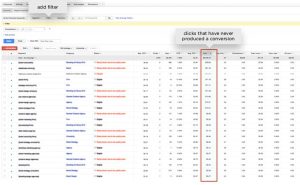
The 4 Most Effective Ways to Reduce Wasted AdWords Search Advertising Spend
For most companies – whether B2B, B2C or B2G – search advertising plays an essential role in lead generation, nurturing and closing. Businesses’ ever-increasing reliance on digital tactics to drive leads and, by extension, sales is logical in our brave, new and (very digital) world: more than 85% of Americans are online regularly; 20%[1] (or about 65 million individuals) are online “almost constantly”. In short: if your company is looking for new customers, the internet is a great place to find them.
However, finding those new customers isn’t always easy – and it’s almost always more expensive than anticipated. For most search advertisers, the higher-than-expected cost of acquiring new customers through search engine marketing (SEM) is a result of wasted spend. The key to making SEM profitable is to “trim the fat” from the account, prioritize the profit-driving elements of your campaign and maximize the lifetime value of each click.
After reviewing more than a few client accounts, we’ve developed several tools and tactics that minimize wasted AdWords search advertising spend and maximize the impact of search advertising. If you’d like us to take a look at your account, drop us a line on our “Free Advice” page.
- Location & Time of Day Controls
Most businesses have a clear understanding of where their target audience is located — whether it’s a 10-mile radius around a store location, within a set of DMAs or across several states.
If you aren’t sure where your target audience is (or if you’d prefer to double-check that your assumptions accurately map onto reality), Google Analytics provides a robust set of tools to help you identify your website traffic sources. To access your report, log in to Analytics, select “Audience,” then “Geo” under the left side navigation menu. Finally, click on “Location”, which will bring you to an interactive map of the world, complete with website usage data. If you have conversion tracking enabled (you should), you can overlay that filter onto your map of website visitors, providing you with a detailed geographic breakdown of your website visitors and converters.
Once you are confident that you’ve identified where your target audience resides, set up AdWords’ geo-targeting to focus your SEM efforts on searchers in only those areas – preventing your ads from running in areas your business doesn’t serve and eliminating spend for clicks that can never help your business.
For some of our clients, simply adding in geo-targeting controls reduced wasted PPC spend by nearly 40%. For businesses currently using location targeting, a best practice to maximize your search advertising spend is to set bid adjustments for specific target areas (zip codes, radii, etc.) within your target market that are generating your highest-quality traffic.
Another best practice to ensure your ads are visible to valuable traffic is to use ad scheduling or “dayparting” to adjust bids based on the hour of the day.
For example, if you own a dry-cleaning business that closes at 6 pm on weekdays and are marketing through call-only ads, it’s a good idea to turn off the ads after 6 pm to avoid paying for calls that no one will answer. Similarly, if you run a B2B marketing agency on the east coast, odds are most of your potential clients won’t be searching for you in the middle of the night. In that case, scheduling a bid adjustment decrease from 8 pm to 7 am can help you minimize spend from clicks that are unlikely to convert.
On the other hand, I’ve worked with multiple accountants and lawyers (especially estate and divorce attorneys) with local practices who receive an incredible number of qualified leads at traditionally off-peak (weekend, late-night) times.
As a general rule, before implementing any bid adjustments or ad scheduling, check your websites’ analytics (use the same procedure as noted above for location; then add time as a secondary dimension) to identify the times with the highest goal completion and conversion rates. Once you feel confident you understand when your target audience is browsing your site, create ad schedules based on: (1) your business type, (2) time zones (if you’re in multiple time zones, you’ll want to schedule different bid adjustments for each time zone) and (3) ad type (for call-only ads, you’ll want to make sure your business is open, etc.).
Once your bid schedules are in place, be sure to monitor them on an on-going basis. A bi-weekly review of an AdWords spend/website traffic by hour of the day report can provide valuable insights and help you maximize your budget. As you review your reports, if you notice a particular time of day is producing a high volume of conversions, schedule a bid increase of 10 or 15% and observe the results. If it produces additional new conversions, keep it. If not, remove it. Likewise, if a time of day is responsible for a large volume of non-converting clicks, consider adding a bid decrease.
- Negative Keywords
Negative keywords are the forgotten uncle of geo-targeting: they’ve been around forever and they’re massively under-appreciated. Put simply, negative keywords are the inverse of a traditional keyword. Where a keyword directs AdWords to “show my ad when a search containing my keyword is queried”, a negative keyword prevents Google from showing your ad for searches containing your negative terms.
Depending on the match type your campaigns employ, negative keywords can be lifesavers. A telecommunications client of ours had previously had a poor experience with search advertising – spending several thousand dollars on a campaign and not receiving a single lead despite more than 1,500 clicks.
As we dug into their campaign, we discovered that the prime culprit behind the failure was a lack of negative keywords. Of the 1,500+ clicks generated, 99.9% were triggered through AdWords’ broad match criterion – and the queries themselves were, by and large, irrelevant to the client’s business. For a company that sells business phone systems, paying $11.58 for “ways to start a business online for free” is a bad idea.
There are two primary approaches to creating a negative keywords list for your search advertising efforts: proactive and reactive. The best practice for almost every business is a hybrid of both methods.
- Avoid Keyword Bloat
For many companies, keyword bloat is a silent revenue killer. Put simply, keyword bloat is what happens when advertisers bid on (way) too many keywords to avoid missing out on potential customers.
The story usually goes something like this: In the beginning, the company’s search advertising efforts are limited to a handful (or fewer) campaigns, each with a half-dozen ad groups and a small, targeted, well-researched group of keywords.
The campaign works well and produces a high return on ad spend (ROAS). Over time, the business grows. Due to its past success, the business owner(s) decide to increase their search advertising efforts. Services and products change. The company enters new markets. Time goes on and terminology changes. New campaigns, ad groups and keywords are added to reflect these changes, but outdated and no longer applicable keywords aren’t removed.
Eventually, the company’s campaigns start to produce fewer conversions despite a relatively constant number of clicks. Search impression share decreases. The campaign’s once-strong (ROAS) begins to plummet.
The symptoms of keyword bloat aren’t as obvious as those of poorly-configured controls –in many cases, the campaign continues to produce a large number of clicks from, prima facie, qualified prospects during prime business hours. The problem is that many of those clicks are generated by unproductive keywords with little (or no) chance of producing a conversion — and preventing your budget from being used by relevant, productive keywords that are generating results. Eventually, this is what happens:

Here’s a quick test you can perform to see if keyword bloat is contributing to your wasted AdWords spend: in the AdWords interface, pull a series of (if you have sufficient data) quarterly reports for the past eighteen to twenty-four months. For each quarter, write down the following metrics: conversion rate; cost per conversion, search impression share. If keyword bloat is a problem for your campaigns, you’ll see a clear pattern emerge as you examine the reports chronologically (start with the oldest and move toward your current report) — your conversion rate and search impression share will decline while your cost per conversion increases.
If you see a massive change in any (or all) of those metrics, keyword bloat is likely costing your company a great deal of money. As a general guideline to what counts as “significant”, look to see if all three metrics are relatively constant (within 15%), both from quarter-to-quarter and from your oldest to your current report. If the metrics are consistent, keyword bloat is likely not a problem for your account.
The most successful strategy for eliminating keyword bloat once it has taken hold of your campaign is to purge the campaign of all of the bloat – all at once. This may sound extreme, but it’s the most effective way I’ve found to eliminate the issue and return your campaign to profitability.
Here’s the procedure:
Step #1: Go to the keywords tab under your bloated campaign.
Step #2: Download and save all of your keyword data (just to be safe).
Step #3: View your campaign data for the past 3-6 months (I usually start with 6 months; if bloating still exists, I’ll reduce the window).
Step #4: Add the following filter: Conversions < 1
Step #5: This will remove all of the keywords that have generated at least one conversion over the period selected in Step #3.
Step #6: Select all of the remaining keywords and remove them.
Step #7: Remove the filter from Step #4. What’s left is every keyword that produced a conversion within the timeframe you selected in Step #2 – your best keywords.
Step #8: Using your updated keyword list, sort by cost per conversion (CPA) and eliminate any remaining keyword with a CPA that is 30% higher than your max. target CPA. If you need help calculating a target CPA, here’s a good resource.
You’re probably thinking this sounds a bit insane, extreme or both – you’ve worked for years building your search campaigns. You’ve meticulously crossed your T’s and dotted your I’s. Now I’m telling you to tear it all down. The reality, for most advertisers, is the digital marketing equivalent of the 80-20 rule: 20% of your keywords drive 80% of your revenue.
This method forces you to focus 100% of your company’s advertising spend (vs. the 20% or less you were previously) only on the keywords that are contributing to your bottom line. For most clients, we’ll see a dramatic turnaround within a month or two – conversion volume and search impression share will increase substantially while CPA decreases.
- Optimize Ad Groups & A/B Test Copy
Once you are confident that your search advertising campaign includes proper controls and a focused list of quality keywords, it is time to hone your search ads.
If your company is similar to most, your search campaigns include a few hundred keywords, broken into 3-7 ad groups, each of which triggers one of two ads. On multiple occasions, we have seen client campaigns with a single, generic ad copied across dozens of ad groups containing thousands of keywords.
The common problem with this structure is twofold: (1) ads for each ad group are virtually identical and generic. This results in a reduced “ad relevance” score and a lower anticipated click through rate (CTR) – two heavily weighted factors in AdWords’ calculation of your keyword Ad Rank. Ultimately, this results in a paying a significantly higher cost per click than your competition. (2) In most cases, having near-identical, generic ads across groups is a result of lumping together a large group of loosely related keywords into a single ad group, preventing the creation of specific, targeted and relevant search ads.
In extreme instances, loosely organized ad groups with generic ad copy can result in paying 30%, 40% or even 70% more for the same click – quickly exhausting your daily budget and missing dozens, hundreds or even thousands of potential customers every day.
To optimize your ad groups, export your revised list (from #3 above) of campaign keywords into an Excel file (alternatively, if Excel makes you uncomfortable, a whiteboard works nicely). Begin by separating your keywords into related “buckets” – this could be by product type (for example, one ad group for shoes, one for bags, one for accessories), service type (e.g. one for divorce law, another for estate law) or theme (dog supplies, cat supplies).
If you are unsure what types of ad group is best, your website structure is a safe place to start. As a rule of thumb, main navigation items or over-arching service areas are best suited to the campaign level; specific products/services/items (subpages and sub-subpages) under the main navigation or over-arching service area provide excellent guidelines for ad groups.
An added benefit to this approach is the ability to use each sub-page as a final URL, directing traffic from individual ad groups to a highly relevant webpage. If the destination website includes landing pages (and it should!), a best practice is to have at least one landing page per campaign (and in most instances, 2 or more landing pages per campaign). Regardless of industry, the ultimate goal of search ads should be to provide the visitor with the maximum amount of relevant information possible based on the searched query.
To accomplish this goal, start with your new ad groups. Review (again) the keywords included, then start brainstorming several versions of ad copy that are specific to the terms included in the ad group. Do not be afraid to be specific – if a prospect is searching for “living wills” or “coach handbags”, the prospect is more likely to click on an ad that prominently includes those terms than a generic ad from a company with which they are unfamiliar.
As a best practice, aim for 3-4 unique search ads per ad group. Once these are complete, review each ad from your prospect’s perspective (or better yet, ask a friend or colleague to review each ad). Picture yourself querying a search for one of the keywords and seeing one of your newly crafted ads. Ask yourself: is this ad relevant? Does it encourage interaction? Would you click it? Through this process, always remember to be honest with yourself – at the end of the day, self-deceit is only going to result in wasted spend and additional time spent correcting the issue.
Once you are confident the newly crafted ads are targeted, relevant and engaging, upload them to their respect ad groups and adjust your campaign ad delivery to “rotate ads evenly for 90 days, then optimize” – then take a step back and allow the ads to run for a set period of time (a month is usually sufficient). Following the pre-determined period, re-visit your ads. Identify the one(s) with the highest CTR and conversion rate and eliminate the others.
If two are within 10-15% of each other, keep both. Your next step here is to begin A/B testing using the “winner” from the above test as a control item. Create new versions with slightly different headline or body copy – but not both. Repeat the above procedure – the goal of A/B testing is to maximize your ad relevance, CTR and conversion rate, optimizing your campaign and reducing your cost per click (CPC). Throughout this process, be impartial and ruthless – no matter how unique, clever or captivating you believe an ad to be, if the data doesn’t support keeping it, don’t.
Done properly, search advertising is one of the most robust, dynamic and effective digital tactics available to marketers today. However, the same features that enable AdWords to be extremely efficient when configured properly can (and do) result in massive wasted spends when advertisers neglect proper controls and configuration. By following the above steps, odds are that you will see an increase in conversions and CTR, coupled with a reduction in wasted spend. If you need assistance or advice on how to overcome your particular PPC challenges, we are willing to provide a bit of free advice.
[1] https://www.pewresearch.org/fact-tank/2015/12/08/one-fifth-of-americans-report-going-online-almost-constantly/






